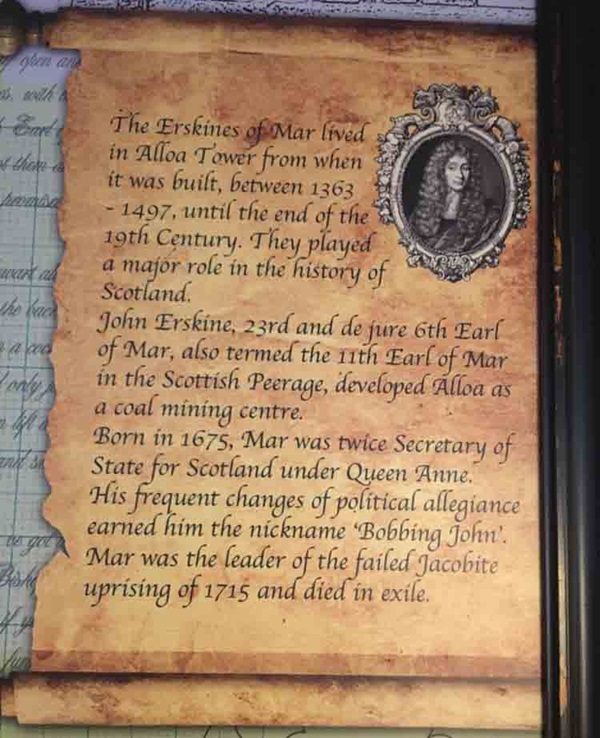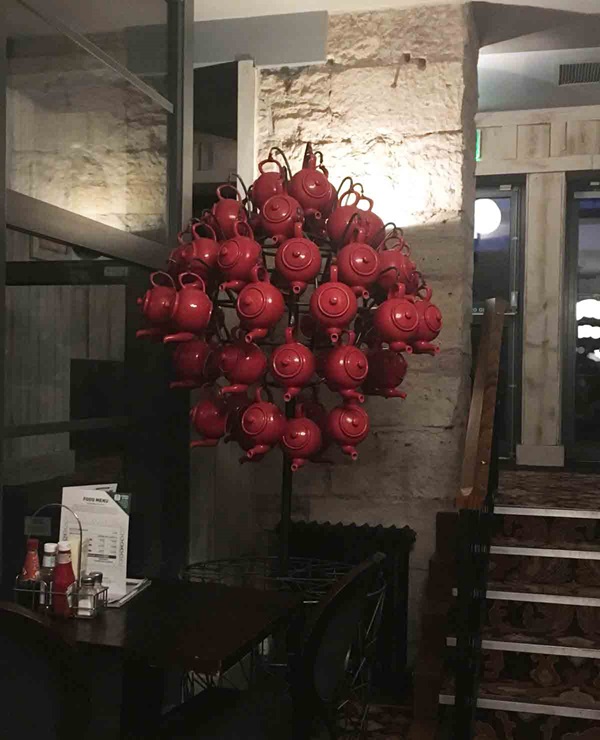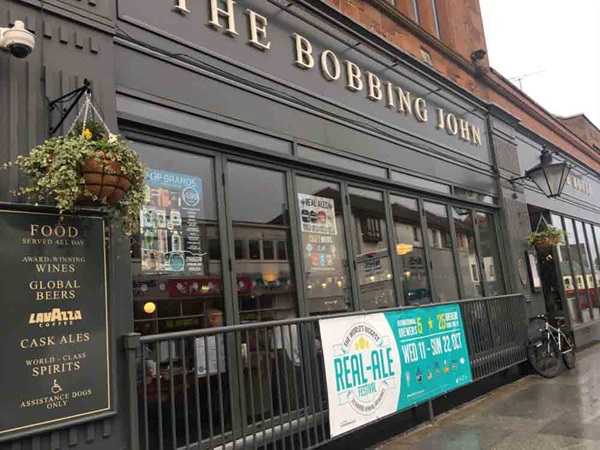John Erskine, the 6th Earl of Mar, created industrial Alloa, developing the town as a coal-mining centre. Born in Alloa, in 1675, Mar was twice Secretary of State for Scotland under Queen Anne. However, his frequent changes of political allegiance earned him the nickname ‘Bobbing John’. Mar was the leader of the failed Jacobite uprising of 1715 and died in exile. His forfeited estates were later purchased by his brother and restored to the Erskine family.
Text about the Alloa glassworks.

The text reads: Alloa glassworks was established in 1750 by Lady Francis Erskine. Workers were trained by craftsmen from Bohemia, who also oversaw the construction of the first glass cone on the site. The structure was 90 feet tall.
By 1850 the Edinburgh Glasgow and Alloa Glass Company owned the site and they built another three cones. The southern cone survived until 1968.
Although glass-making is an ancient process, it was carried out on a small scale until the development of industrial style methods in Europe allowed it to be mass-produced.
The main industry in Alloa was coal-mining but it was also known for weaving and glass-making. The latter being Alloa’s one big industrial survivor. The works have been on the same site longer than any other glassworks in Europe.
A photograph and text about the Alloa colliery.

The text reads: The Alloa colliery was drained by an overshot water wheel 30 foot in diameter. It lifted the water from a depth of 300 ft. The Overshot Water Wheel is a Roman innovation and designed to remove water from the lowest levels of underground workings, hence the use of one in Alloa collieries.#
Prints and text about coal-mining in Alloa.

The text reads: Alloa coal-mining was developed by John Erskine, the 6th Earl of Mar. The Earls of Mar owned many of the coal mines. Robert Bald, a local mining engineer, was contracted to provide water power from the Garthorn dam to operate the mines and other industries.
An illustration and text about the Erskines of Mar.

The text reads: The Erskines of Mar lived in Alloa Tower from when it was built, between 1363-1497, until the end of the 19th century. They played a major role in the history of Scotland.
John Erskine, 23rd and de jure 6th Earl of Mar, also termed the 11th Earl of Mar in the Scottish Peerage, developed Alloa as a coal-mining centre.
Born in 1675, Mar was twice secretary of state for Scotland under Queen Anne. His frequent changes of political allegiance earned him the nickname ‘Bobbing John’. Mar was the leader of the failed Jacobite uprising of 1715 and died in exile.
A photograph and text about John Paton and James Baldwin.

The text reads: The business began as two separate companies founded in the 1770s by John Paton of Alloa and James Baldwin of Halifax. Both individuals had separately formed their businesses using the spinning mule and both produced mainly yarns for commercial knitting machines.
The Paton family were regarded as generous benefactors in Alloa, where they provided funding for public buildings such as the town hall, public libraries, a school, a swimming pool and a gymnasium.
The two companies merged in 1920 and diversified into producing wool for hand knitters, as well as knitting patterns.
Artwork entitled Patons Bobbles.

The text reads: This wool bobble artwork took its inspiration from the famous Patons of Alloa, representing the wool yarn factory.
In 1920 John Patton of Alloa (whose family founded the company in the 1770s) and James Baldwin of Halifax merged the two companies to create Patons and Baldwins. They diversified into producing wool for home knitters as well as publishing knitting patterns.
In the 1930s they expanded across the world with establishments in Scotland, the north of England, Canada and New Zealand.
In 1946 building began on a 140 acre site in Darlington. Patons and Baldwins’ five million pound factory was hailed as “the most modern and largest single storey plant of its kind in the world”.
In 1961 Patons and Baldwins merged with J and P Coats of Glasgow becoming J and P Coats, Patons and Baldwins, otherwise known as Coats Patons, the country’s largest textile group with assets of £130 million.
During the 1960s further mergers with Pasold, Sidney Bellman and Jaeger ensued.
In 1999, the Kilncraigs Mill in Alloa closed in December.
In 2001 the name changed to Coats.
A sculpture entitled Treepot.

The text reads: The pottery history of Alloa is a long and well established one. It is believed that the industry began around 1783 and grew to produce over 40,000 teapots every week.
Unfortunately the pottery industry no longer exists in Alloa. However, there are still many pieces of Alloa pottery that have survived.
It is Alloa’s pottery history that has influenced our Treepot sculpture which has been created using a steel frame and ceramic teapots.
External photograph of the building – main entrance.

If you have information on the history of this pub, then we’d like you to share it with us. Please e-mail all information to: pubhistories@jdwetherspoon.co.uk